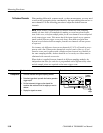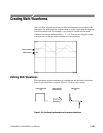
Creating Math Waveforms
CSA8000B & TDS8000B User Manual
3-103
The key points that follow describe considerations for creating math waveforms
that best supports your data-analysis tasks.
How to Create. You create math waveforms when you create a math expression.
You do so by applying numerical constants, math operators, and functions to
operands, which can be channel, waveforms, reference waveforms, measure-
ments (scalars), or fixed scalars. You can display and manipulate these derived
math waveforms much like you can the channel and reference waveforms (see
Operations on Math Waveforms on page 3--107).
Some examples of typical math waveforms follow.
Table 3- 8: Math expressions and the mat h waveforms produced
To... Enter this math expression... and get this math waveform...
...normalize a waveform ... ...shifted and scaled to fit a std. template
CHAN1
Source waveform
1.6V
0.8V
(C1 -- Meas1)/ Meas2,
where
C1 is waveform shown lef t
Meas1 = Low of C1
Meas2 = amplitude of C1
1.05V
1.00V
0.95V
+0.05V
0.00V
--0.05V
Normalized math waveform
...simulate ac coupling and integrate ... ...D C component removed before integr ation
CHAN1
Source waveform
5.0 V
1.0V
Intg(C1--Meas1),
where
C1 is waveform shown lef t
Meas1 is set to take the Mean of C1
-- 3V
AC integrationmath waveform
+3V
Sources. Math Waveforms can incorporate the following sources:
H Channel waveforms
H Reference waveforms
H Measurement scalars (automated measurements) that measure channel or
reference waveforms in any time base
H Fixed scalars that you enter as numerical constants in expressions
Keys to Using


















